
"Fresh Air By Meldrum" Open element air cleaner

DML FAQ : HOWTO : "Fresh Air By Meldrum" Open element air cleaner
This particular installation covers 1997+ Dodge Dakota 3.9L and 5.2L 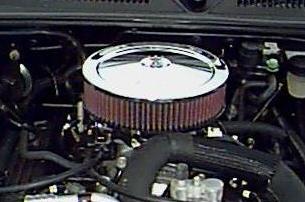 Magnum engines, 1998+ Dodge Durango, & the Dakota R/T. Assembly will fit older model Dakotas and may fit 93+ Dodge Ram but installation procedureand clearances will vary. Be sure to check out the pics of DML members trucks to see a few examples of open element air cleaner assemblies on the previous geveration trucks. Click any installation image on page for larger view.
Magnum engines, 1998+ Dodge Durango, & the Dakota R/T. Assembly will fit older model Dakotas and may fit 93+ Dodge Ram but installation procedureand clearances will vary. Be sure to check out the pics of DML members trucks to see a few examples of open element air cleaner assemblies on the previous geveration trucks. Click any installation image on page for larger view.
Note:The assembly, as I installed it, does not provide adequate airflow for all out racing requirements of the 5.2L or for the 5.9L R/T. What it does provide is a great performance improvement for anything but constant redline rpm use and it's a simple drop in. No fit problems and no hassles. Yes, a 14" will fit but it's a tighter squeeze. Based on required filter area the FABM's 10" diameter can more than cover everything from a 3.9L to the R/T if you're smart in selecting your filter height. If you just gotta have a 14" can though or you plan to race the truck regularly, I'd recommend the Edelbrock p/n 1221 drop base air cleaner assembly and the Edelbrock p/n 8093 1/2" spacer. This, in conjunction with dialing the S-bolt out a few turns or making the necessary adjustments to the stock bracket/bolt assembly, will just sneak a 14" x 3" under the hood. K&N's 14x3 element is p/n 1650. Summit Racing has a no-name version that's cheaper under p/n SUM-239143.
Air Filter Selection:
An average foam filter will flow 4.38 cfm/sq-in. A good paper filter will flow 4.95 cfm/sq-in. An oiled cotton gauze (K&N) will flow 6.03 cfm/sq-in.
To get your required filtered surface area for a oiled cotton gauze filter use the following formula:
| A = |
|
|
where |
|
| A |
= |
effective filtering area (square inches) |
| CID |
= |
cubic inch displacement |
| RPM |
= |
rev./min. at max power |
|
Then using the following modifying factors if using an alternative filter media:
A * 1.3767 = required surface area for foam element
A * 1.2181 = required surface area for paper element
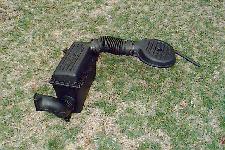 The stock air intake system isn't all bad. It does an effcient job of catching cooler, outside air and quieting the rushing intake charge. Performance wise, however, the stock system's small inlet tubing, multiple bends, kinks, and cross-sectional changes, hinder incoming air flow. We all know to make horsepower you need adequate air flow.
The stock air intake system isn't all bad. It does an effcient job of catching cooler, outside air and quieting the rushing intake charge. Performance wise, however, the stock system's small inlet tubing, multiple bends, kinks, and cross-sectional changes, hinder incoming air flow. We all know to make horsepower you need adequate air flow.
There is an inexpensive alternative that will not only increase performance, but add a bit of flash to your engine compartment and provide an enhanced performance sound on acceleration.
The system consists of:
- (1) 10" diameter chrome air cleaner
- Edelbrock Signature Series p/n 1208 (recommended - has integral breather hose nipple)
- Proform p/n SAP-66802 - smooth lid....nothing stamped in cover
- Erson p/n ERS981102 - Erson stamped in lid
- Mr. Gasket p/n 9791 - plastic nipple for breather hose
- (1) K&N 10" diameter filter - recommendations based on Edelbrock 1208 can
- E-1070 - 10 x 2.00 (recommended by RPM for 3.9L use)
- E-1088 - 10 x 2.06
- E-1080 - 10 x 2.25 (recommended by RPM)
- E-1090 - 10 x 2.31
- E-2764 - 10 x 2.50
- E-1095 - 10 x 2.56 (recommended by RPM for high rpm or daily R/T/Durango 5.9L use)
- E-9080 - 10 x 2.75 (recommended by RPM for Dakota R/T and Durango 5.9L)
- E-1120 - 10 x 3.00 (recommended by RPM for high rpm Dakota R/T and Durango 5.9L - check clearances!!)
- Modification of stock breather tube/hose assembly or a short length of 19/32" emissions hose or close equivalent.
- Modification of stock throttle body air hat hold-down bracket assembly or custom S-bolt.
Installation:
(The weak at heart can skip the air box & inlet tube removal steps but this creates a perfect area for a CD ignition)
Step 1 |
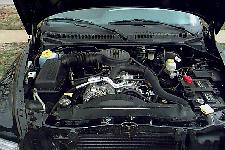 |
Here's where we begin. Start by removing throttle body air hat & inlet tube and breather tube/hose assembly. Remove the filter box-to-air hat hose and place all pieces to the side. |
Step 2 |
| Cut the plastic rivet on the inlet air "horn" that holds it to the inner fender and disconnect piece from air box. |
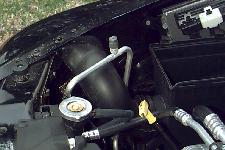 |
Step 3 |
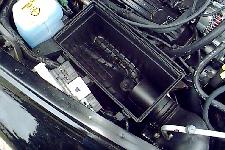 |
Remove stock filter from air box. Remove mounting nuts from inside of air box. Two of the nuts on the bottom of the air box are alignment studs and really aren't removable. You just pull the air box from engine compartment. |
Step 4 |
| Remove air hat hold-down bracket from throttle body. You need to 1) replace front bolt with 1-1/2" 1/4-20 thumbscrew, placing locknut on underside of bracket to act as a spacer, or 2) replace rear carriage bolt with 1/4-20 bolt of required longer length, or 3) replace with an S-bolt. |
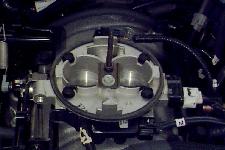 |
Step 5 |
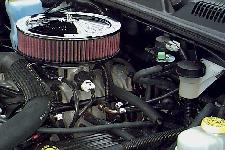
| Install air cleaner/K&N assembly & modified hold-down bracket. Measure emissions hose for desired routing, cut to length, and install between breather and air cleaner (air cleaner has breather hose adapter on bottom surface). DO NOT leave the breather disconnected. The breather is an integral part of the engine's design. If you do not wish to have the breather attached to the can you must replace the stock breather with an aftermarket filtered breather. |
Step 6 |
| Make sure everything is snug and take the truck for a spin around the block. For '96 and newer trucks, the OBDII operating system is extremely quick to adapt to improvements to the performance of the engine. Unlike pre-OBD II systems, which took a day or two to adapt to performance modifications, OBD II will give noticable improvements almost immediately. |
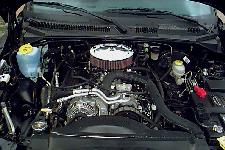 |
This upgrade will give increased performance, improved fuel economy (if you can stay off the loud pedal long enough), and a fantastic engine roar on acceleration that's reminiscent of the secondaries opening on a Holley 4V carb. Enjoy.
Points of interest:
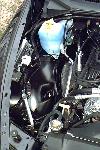 |
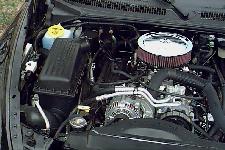 |
| The empty space left by the removal of the filter box is perfect for an Capacitive Discharge ignition box or even a small nitrous bottle! |
An option if you decide to leave the filter box in place could be to route a discharge hose in close proximity to the FABM. This would help duct colder air to the can. Just remember to leave the stock filter out of the box. You might even route some dryer vent hose from the inlet of the box to the outlet (within the box itself). |
Should you have any questions about this mod please feel free to email Sean Meldrum at 
- Thanks to Stephan Boianoff for the install pics as I did not have the forethought to capture my own installation a year ago.
- Thanks to Jon Steiger for posting this mod and for providing a common place for us Dakota motorheads to hang out!
Contributed by: Sean Meldrum
Last updated: Sun Jul 20 10:35:59 2003
![]()
![]()
 Magnum engines, 1998+ Dodge Durango, & the Dakota R/T. Assembly will fit older model Dakotas and may fit 93+ Dodge Ram but installation procedureand clearances will vary. Be sure to check out the pics of DML members trucks to see a few examples of open element air cleaner assemblies on the previous geveration trucks. Click any installation image on page for larger view.
Magnum engines, 1998+ Dodge Durango, & the Dakota R/T. Assembly will fit older model Dakotas and may fit 93+ Dodge Ram but installation procedureand clearances will vary. Be sure to check out the pics of DML members trucks to see a few examples of open element air cleaner assemblies on the previous geveration trucks. Click any installation image on page for larger view. The stock air intake system isn't all bad. It does an effcient job of catching cooler, outside air and quieting the rushing intake charge. Performance wise, however, the stock system's small inlet tubing, multiple bends, kinks, and cross-sectional changes, hinder incoming air flow. We all know to make horsepower you need adequate air flow.
The stock air intake system isn't all bad. It does an effcient job of catching cooler, outside air and quieting the rushing intake charge. Performance wise, however, the stock system's small inlet tubing, multiple bends, kinks, and cross-sectional changes, hinder incoming air flow. We all know to make horsepower you need adequate air flow.